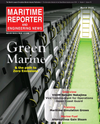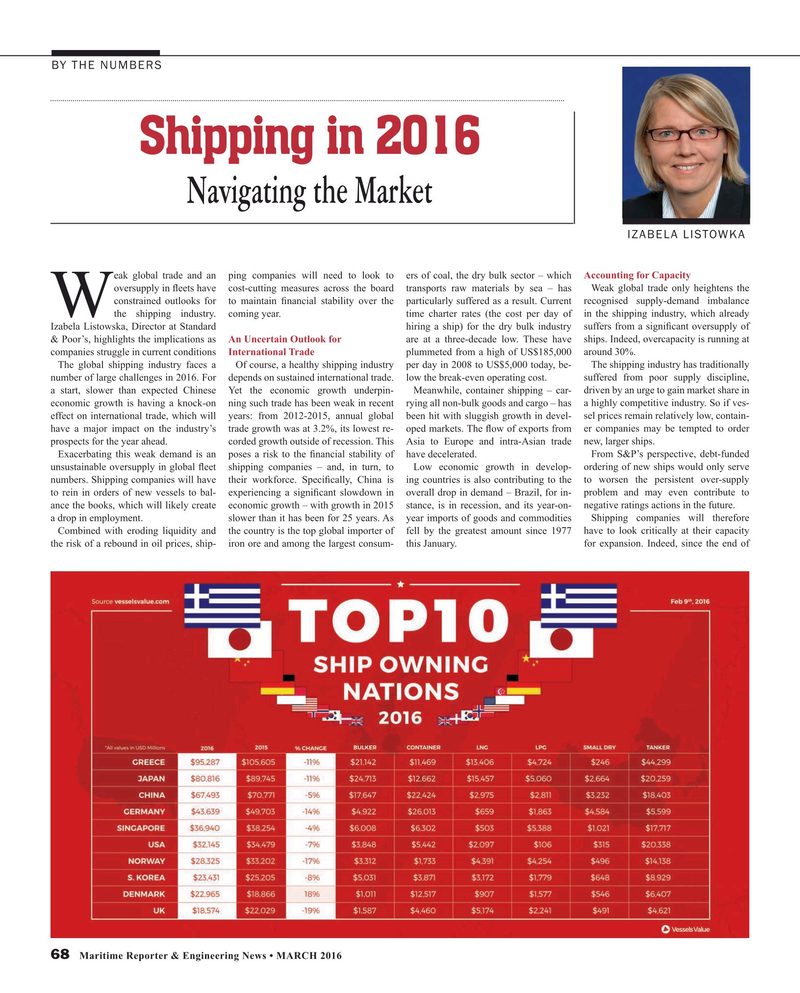
Page 68: of Maritime Reporter Magazine (March 2016)
Green Marine Technology
Read this page in Pdf, Flash or Html5 edition of March 2016 Maritime Reporter Magazine
BY THE NUMBERS
Shipping in 2016
Navigating the Market
IZABELA LISTOWKA eak global trade and an ping companies will need to look to ers of coal, the dry bulk sector – which Accounting for Capacity oversupply in ? eets have cost-cutting measures across the board transports raw materials by sea – has Weak global trade only heightens the constrained outlooks for to maintain ? nancial stability over the particularly suffered as a result. Current recognised supply-demand imbalance
Wthe shipping industry. coming year. time charter rates (the cost per day of in the shipping industry, which already
Izabela Listowska, Director at Standard hiring a ship) for the dry bulk industry suffers from a signi? cant oversupply of & Poor’s, highlights the implications as An Uncertain Outlook for are at a three-decade low. These have ships. Indeed, overcapacity is running at companies struggle in current conditions International Trade plummeted from a high of US$185,000 around 30%.
The global shipping industry faces a Of course, a healthy shipping industry per day in 2008 to US$5,000 today, be- The shipping industry has traditionally number of large challenges in 2016. For depends on sustained international trade. low the break-even operating cost. suffered from poor supply discipline, a start, slower than expected Chinese Yet the economic growth underpin- Meanwhile, container shipping – car- driven by an urge to gain market share in economic growth is having a knock-on ning such trade has been weak in recent rying all non-bulk goods and cargo – has a highly competitive industry. So if ves- effect on international trade, which will years: from 2012-2015, annual global been hit with sluggish growth in devel- sel prices remain relatively low, contain- have a major impact on the industry’s trade growth was at 3.2%, its lowest re- oped markets. The ? ow of exports from er companies may be tempted to order prospects for the year ahead. corded growth outside of recession. This Asia to Europe and intra-Asian trade new, larger ships.
Exacerbating this weak demand is an poses a risk to the ? nancial stability of have decelerated. From S&P’s perspective, debt-funded unsustainable oversupply in global ? eet shipping companies – and, in turn, to Low economic growth in develop- ordering of new ships would only serve numbers. Shipping companies will have their workforce. Speci? cally, China is ing countries is also contributing to the to worsen the persistent over-supply to rein in orders of new vessels to bal- experiencing a signi? cant slowdown in overall drop in demand – Brazil, for in- problem and may even contribute to ance the books, which will likely create economic growth – with growth in 2015 stance, is in recession, and its year-on- negative ratings actions in the future. a drop in employment. slower than it has been for 25 years. As year imports of goods and commodities Shipping companies will therefore
Combined with eroding liquidity and the country is the top global importer of fell by the greatest amount since 1977 have to look critically at their capacity the risk of a rebound in oil prices, ship- iron ore and among the largest consum- this January. for expansion. Indeed, since the end of 68 Maritime Reporter & Engineering News • MARCH 2016
MR #3 (62-69).indd 68 3/3/2016 10:35:12 AM

 67
67

 69
69
